食用果仁列表
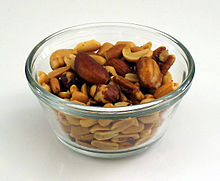
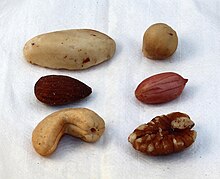
食用果仁是指脱水后的水果或植物种子,其中大部分果仁的脂肪含量较高,当然也有例外。果仁有多种食用方式,包括但不限于烘焙、即食或者用于调味。除了坚果外,可以食用的水果或植物的种子同样被视为食用果仁。[1]以下四种水果或种子可以视为食用果仁:
- 坚果:干燥、硬壳、未隔间的果实,成熟时果皮不会开裂释放种子(例如榛子)[2][3]
- 核果:植物种子被果核包裹,同时果核周围被果肉包裹(例如扁桃或核桃)[4]
- 裸子植物的种子:特点是胚珠裸露, 不為子房所包被(例如松子)
- 被子植物的种子:特点是种子有较为完整的保护构造(例如花生)
人类食用坚果的历史非常悠久。对于许多美洲原住民而言,包括橡子、美洲山毛榉等在内的各种坚果在数千年来一直是其淀粉和脂肪的主要摄取来源。[5]除此之外,澳大利亚原住民在过去数个世纪也将各种坚果当作食物。[6]很多自古以来就被人类所食用的坚果在进入现代社会后需求量急剧增加,花生就是其中的典型代表。根据植物学家乔治·华盛顿·卡弗的研究发现,种植花生可以改良棉花田的土壤,因此花生这种作物得以在美国大范围推广。[7]
坚果
[编辑]
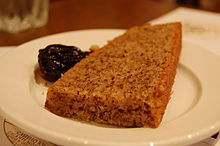

以下为可食用的坚果:
- 榛子:自古以来便是美洲原住民的主食,可以用于面包烘焙或煮粥。[8]
- 山毛榉:
- 面包坚果:被古玛雅人用作动物饲料,不过在其他作物产量不足时也会直接食用。[11]
- 石栗:出现于许多东南亚美食中。[12]
- 栗子:
- 几内亚花生:可以煮或烤[15],味道和花生类似,甚至还可以将烤过的种子磨成热饮。[16]
- 榛子:市面上大多数榛子为欧洲榛子,[17]可以用于制作果仁糖、能多益酱、力娇酒和许多其他食物。
- 约翰斯通河杏仁:澳大利亚北部原住民的珍贵食物。[19]
- 卡鲁卡树坚果:原产于巴布亚新几内亚。人工栽培种和野生种都可以生吃、烤制或煮熟,从而在其他食物供应不足的情况下可以用于保证粮食安全。[20]
- 可乐果:与南美洲的可可有关,是可乐的成分之一,也是该种饮料的命名由来。[22]
- 酒瓶树果实:原产于澳大利亚,被澳大利亚北方原住民视为重要的丛林食物。[23]
- 马拉巴栗:生吃味道和花生很像,烤熟后味道和腰果以及甜栗相似。[24]
- 蒙贡果:喀拉哈里沙漠住民布须曼人的主要蛋白质来源。[25]还可以用于提炼护肤精油。[26]
- 油棕果实:非洲辛巴人的重要应饥食品。[27]
- 玫瑰果:原产于澳大利亚东海岸。[28]脂肪含量低,钙和钾含量高,是重要的从林食物。经常和夏威夷果所混肴。
- 黄胡桃:原产于澳大利亚,是当地原住民的主食。[29]
核果种子
[编辑]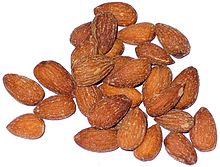
一些核果的种子是重要的可使用果仁。
- 杏仁:作为一种食物有着悠久的历史以及重要的宗教、社会和文化意涵。[30]据推测,杏仁起源于中亚,是一种自然形成的杂交品种,在古代传就播到整个中东,然后传播到整个欧亚大陆。除此之外,杏仁和开心果还是《圣经》中唯二提到的两种坚果。[31]
- 杏核:杏组植物的核经常用于替代杏仁,在德式圣诞蛋糕中较为常见。
- 肉托果:昆士兰州东北部与北领地原住民的主要食物。[32]
- 巴鲁坚果:生活在巴西塞拉多非裔巴西人的食物来源,烤熟或煮熟后食用。
- 槟榔果:咀嚼食用,[33]还可以用于制作印式餐后甜点以及清新口气。[34]
- 娑罗树果实:生长于东南亚热带雨林,可以用来成产食用油。[35]
- 橄榄属:
- 腰果:生长于腰果梨下方,为腰果树的果实。[39]腰果原产于巴西东北部,在16世纪时被引入印度和东非,并且在是这些地方的重要经济作物。腰果在食用前必须经过烘烤(或蒸煮)以去除腐蚀性壳油。[40]
- 智利榛:原产于南美洲的一种常绿植物,外观和味道与榛子相似。[41]
- 椰子:世界性的食物,种子的肉质部分可食用,椰子油也可以用于烹饪。[42]
- 加蓬坚果:味道和榛子或栗子类似,可以生吃或烤熟后食用。[43]
- 山核桃:
- 假芒果属:原产于非洲
- 菠蘿蜜种子:味道像栗子,脂肪含量较低。[49]
- 布迪椰子:果核和果肉皆可食用。
- 面包坚果:味道像栗子,脂肪含量较低。
- 熊猫油榄:原产于加蓬,食用方式和灌木芒果类似,也可以用于榨取食用油。[50]
- 油桃木:也称几内亚奶油果,可以榨取珍贵的食用油。[35]
- 开心果:原产于西亚,有上千年的栽培历史,[51]和杏仁一样,是圣经中唯二提到的坚果。[31]
- 核桃:
坚果状裸子植物种子
[编辑]
裸子植物的胚珠裸露, 不为子房所包被。以下所有植物除了银杏外均为常绿植物。
坚果状被子植物种子
[编辑]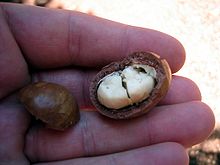
又称开花植物,其种子受保护程度较高。
- 巴西坚果:每年大约收获250,000–400,000棵树的果实,可以用于糖果制造和糕点烘培的高价值食用坚果。[65]
- 夏威夷果:目前主要产于夏威夷和澳大利亚,这两个地方的夏威夷果都原产于澳大利亚。夏威夷果是一种非常有价值的食用坚果,其中品相不好的坚果通常用于提取食用油。[35]
- 奶油坚果:原产于亚马逊热带雨林,受到当地土著部落的高度认可。[67]
- 花生:原产于南美洲,由于乔治·华盛顿·卡弗在20世纪初的研究成果,目前已经从一种小众农作物发展成为了全球性的商业作物。[7]
- 树花生:原产于澳大利亚,不同于花生。[68]
- 大豆:是东亚的原生种植物,重要的油料作物。[69]
参考文献
[编辑]- ^ Bewley, J. Derek; Black, Michael; Halmer, Peter. The encyclopedia of seeds: science, technology and uses. CABI. 2006: 444 [2011-11-21]. ISBN 0-85199-723-6.
- ^ Nut. The American Heritage® Dictionary of the English Language Fourth. Houghton Mifflin Company. 2000 [2011-11-21]. (原始内容存档于2011-10-10). (页面存档备份,存于互联网档案馆)
- ^ Nuts and derived products. Definition and Classification of Commodities. 联合国粮食及农业组织. 1996 [2011-11-21]. (原始内容存档于2018-12-24). (页面存档备份,存于互联网档案馆)
- ^ Drupe. Collins English Dictionary – Complete and Unabridged 11th Edition. Harper-Collins Publishers. 2012 [2012-09-05]. (原始内容存档于2012-10-31). (页面存档备份,存于互联网档案馆)
- ^ Moerman 2010.
- ^ Clarke, Philip A. Aboriginal plant collectors: botanists and Australian aboriginal people in the nineteenth century. Rosenberg Pub. 2008 [2011-11-21]. ISBN 978-1-877058-68-4.
- ^ 7.0 7.1 History of peanuts. National Peanut Board. [2011-11-22]. (原始内容存档于2007-10-23). Archive.is的存檔,存档日期2007-10-23
- ^ Moerman 2010,第206–212頁.
- ^ Moerman 2010,第114頁.
- ^ Janick 2008,第405頁.
- ^ The Book of Edible Nuts. Courier Dover Publications. 2004: 276 [2011-11-21]. ISBN 0-486-43499-0.
- ^ Laudan, Rachel. The food of Paradise: exploring Hawaii's culinary heritage. University of Hawaii Press. 1996: 231 [2011-11-21]. ISBN 0-8248-1778-8.
- ^ Simoons, Frederick J. Food in China: a cultural and historical inquiry. CRC Press. 1991: 268 [2011-11-21]. ISBN 0-8493-8804-X.
- ^ Shakuntala, N.; Manay, O. Food: Facts And Principles Second. New Age International. 2001: 307 [2011-11-21]. ISBN 81-224-1325-0.
- ^ Pachira glabr Saba Nut, American Chestnut PFAF Plant Database. pfaf.org. [2022-09-11]. (原始内容存档于2022-09-11). (页面存档备份,存于互联网档案馆)
- ^ Morse, Clinton. Pachira glabra {Malvaceae} Guinea Peanut. florawww.eeb.uconn.edu. [2022-09-11].
- ^ 17.0 17.1 17.2 Thompson, Maxime M.; Lagerstedt, Harry B.; Mehlenbacher, Shawn A. Hazelnuts. Janick, Jules; Moore James N. (编). Nuts. Fruit Breeding 3. 1996-05-02: 125ff [2011-11-21]. ISBN 9780471126690.
- ^ 18.0 18.1 18.2 Smith, Andrew F. The Oxford companion to American food and drink. Oxford University Press. 2007: 219 [2011-11-21]. ISBN 978-0-19-530796-2.
- ^ Clarke, Philip A. Aboriginal plant collectors: botanists and Indigenous Australians in the nineteenth century. Rosenberg Pub. 2008: 34 [2011-11-21]. ISBN 978-1-877058-68-4.[失效連結]
- ^ Bourke, R. M.; Allen, M. G.; Salisbury, J. G. Food security for Papua New Guinea: proceedings of the Papua New Guinea Food and Nutrition 2000 Conference. PNG University of Technology. 2001-08-31 [2012-01-16]. ISBN 1-86320-308-7.
- ^ 21.0 21.1 Bourke, R. Michael; Harwood, Tracy. Food and Agriculture in Papua New Guinea. Australian National University. 2009: 216 [2011-11-22]. ISBN 978-1-921536-60-1.
- ^ Attokaran, Mathew. Natural Food Flavors and Colorants. John Wiley & Sons. 2011: 64 [2011-11-21]. ISBN 978-0-8138-2110-8.
- ^ Dixon, Robert M. W.; Moore, Bruce. Australian Aboriginal words in English: their origin and meaning Second. Oxford University Press. 2006: 114 [2011-11-21]. ISBN 0-19-554073-5.
- ^ Edible: an illustrated guide to the world's food plants. National Geographic Books. 2008: 245. ISBN 978-1-4262-0372-5.
- ^ Lee, Robert B. Hunter-Gatherers in Process: The Kalahari Research Project, 1963-1976 (PDF). Academic Press. 1979: 319 [2011-11-22]. (原始内容存档 (PDF)于2022-07-09). (页面存档备份,存于互联网档案馆)
- ^ Bafana, Busani. Mongongo–a tough nut worth cracking. New Agriculturist. July 2009 [2011-04-28]. (原始内容存档于2016-03-19). (页面存档备份,存于互联网档案馆)
- ^ Bollig, Michael, Risk management in a hazardous environment: a comparative study of two pastoral societies, Studies in human ecology and adaptation 2 (Birkhäuser), 2006, 2: 193 [2011-11-22], ISBN 0-387-27581-9
- ^ Janick, Jules; Paull, Robert E. The encyclopedia of fruit & nuts. CABI. 2008: 600 [28 May 2010]. ISBN 978-0-85199-638-7.
- ^ Harris, Marvin; Ross, Eric B. Food and Evolution: Toward a Theory of Human Food Habits. Temple University Press. 1989: 364 [2011-11-22]. ISBN 0-87722-668-7.
- ^ History of Almonds. Almond Board of California. [2011-11-22]. (原始内容存档于2011-11-26). (页面存档备份,存于互联网档案馆)
- ^ 31.0 31.1 McNamee, Gregory. Movable feasts: the history, science, and lore of food. Greenwood Publishing Group. 2007: 2. ISBN 978-0-275-98931-6.
- ^ Janick 2008,第29頁.
- ^ Betel chewing. Singapore Infopedia. National Library Singapore. May 5, 1999. (原始内容存档于October 15, 2008). (页面存档备份,存于互联网档案馆)
- ^ Betelnut–food. Plant Cultures. [2011-11-22]. (原始内容存档于2011-09-18). (页面存档备份,存于互联网档案馆)
- ^ 35.0 35.1 35.2 Axtell, B.L. from research by R.M. Fairman. Minor oil crops. 联合国粮食及农业组织. 1992 [2011-11-18]. (原始内容存档于2016-05-18). (页面存档备份,存于互联网档案馆)
- ^ Canarium indicum var. indicum and Canarium harveyi (canarium nut) (PDF), Species Profiles for Pacific Island Agroforestry, April 2006: 2 [2011-11-22], (原始内容存档 (PDF)于2013-12-16) (页面存档备份,存于互联网档案馆)
- ^ Newman, Jacqueline M. Food culture in China. Food culture around the world. Greenwood Publishing Group. 2004: 47 [2011-11-22]. ISBN 0-313-32581-2.
- ^ What is the history of pili nuts?. PiliNuts.org. [2011-11-22]. (原始内容存档于2011-11-06). (页面存档备份,存于互联网档案馆)
- ^ Bewley, J. Derek; Black, Michael; Halmer, Peter. The encyclopedia of seeds: science, technology and uses. CABI. 2006: 61 [2011-11-22]. ISBN 0-85199-723-6.
- ^ Rieger, Mark. Introduction to fruit crops. Psychology Press. 2006: 135–136. ISBN 1-56022-259-X.
- ^ Edible Nuts 2004,第281-282頁.
- ^ Santos, GA; Batugal, P.A.; Othman, A.; Baudouin, L.; Labouisse, J.P. (编). Botany of the Coconut Palm. Manual on Standardized Research Techniques in Coconut Breeding. International Plant Genetics Research Institute. [2011-11-21]. (原始内容存档于2012-03-23). (页面存档备份,存于互联网档案馆)
- ^ Coula edulis. World Agroforestry Tree Database. [2011-11-22]. (原始内容存档于2012-04-06). (页面存档备份,存于互联网档案馆)
- ^ Brill, Steve; Dean, Evelyn. Identifying and Harvesting Edible and Medicinal Plants. HarperCollins. 1994: 171 [2011-12-04]. ISBN 0-688-11425-3.
- ^ The History of Pecans, A Pecan Timeline and Fun Facts. National Pecan Shellers' Association. [2011-11-22]. (原始内容存档于2011-10-06). (页面存档备份,存于互联网档案馆)
- ^ Grauke, L.J. C. ovata (Mill.) K. Koch. Shagbark hickory. USDA-ARS Pecan Genetics. [2011-11-22]. (原始内容存档于2011-12-02). (页面存档备份,存于互联网档案馆)
- ^ Neso, Guy. Shellbark Hickcory–Carya laciniosa (Michx. f.) G. Don (PDF). USDA. [2011-11-22]. (原始内容存档 (PDF)于2022-09-11). (页面存档备份,存于互联网档案馆)
- ^ 48.0 48.1 Janick 2008,第420頁.
- ^ Edible Nuts 2004,第294頁.
- ^ van der Vossen, H.A.M. & Mkamilo, G.S., Vegetable oils, Plant resources of tropical Africa 14 (PROTA), 2007, 14: 129, ISBN 978-90-5782-191-2
- ^ History of the pistachio - in a nutshell. Pistachio Growers Association. [2011-11-22]. (原始内容存档于2011-08-27). (页面存档备份,存于互联网档案馆)
- ^ Angier, Bradford. Field guide to edible wild plants
 . Stackpole Books. 1974: 38 [2011-11-22]. ISBN 0-8117-2018-7.
. Stackpole Books. 1974: 38 [2011-11-22]. ISBN 0-8117-2018-7. black walnut.
- ^ Moerman 2010,第132頁.
- ^ Ramos, David E. Walnut production manual. ANR Publications. 1997: 8 [2011-11-22]. ISBN 1-879906-27-9.
- ^ Edible Nuts 2004,第288頁.
- ^ Robinson, Les. Aboriginal Uses of Plants Around Sydney. SGAP 17th Biennial Seminar (Robert Menzies College, Sydney). [2011-11-22]. (原始内容存档于2011-10-15). (页面存档备份,存于互联网档案馆)
- ^ Simoons, Frederick J. Food in China: a cultural and historical inquiry. CRC Press. 1991: 274 [2011-11-22]. ISBN 0-8493-8804-X.
- ^ 58.0 58.1 Nugent 2004,第41頁.
- ^ Nesbitt, Mark. The Cultural history of plants. Taylor & Francis. 2005: 140 [2011-12-03]. ISBN 0-415-92746-3.
- ^ Dewan, M. L.; Nautiyal, M. C.; Sah, V. K.; Trees for Life, India (Organization). Nut fruits for the Himalayas. Concept Publishing Company. 1992: 114–116 [2011-11-22]. ISBN 81-7022-399-7.
- ^ C.A.B. International. Pines of silvicultural importance. CABI. 2002: 113 [2011-11-22]. ISBN 0-85199-539-X.
- ^ 62.0 62.1 Janick 2008,第595頁.
- ^ Nugent 2004,第43頁.
- ^ Nugent 2004,第44頁.
- ^ Alasalvar, Cesarettin; Shahidi, Fereidoon. Tree nuts: composition, phytochemicals, and health effects. CRC Press. 2008: 148 [2011-11-22]. ISBN 978-0-8493-3735-2.
- ^ 66.0 66.1 Rieger, Mark. Introduction to fruit crops. Psychology Press. 2006: 259 [2011-11-23]. ISBN 1-56022-259-X.
- ^ Edible Nuts 2004,第306頁.
- ^ Isaacs, Jennifer. Bush food: Aboriginal food and herbal medicine. Weldons. 1987: 85 [2011-11-22]. ISBN 0-949708-33-X.
- ^ Edible Nuts 2004,第324頁.
参考书目
[编辑]- Moerman, Daniel E. Native American Food Plants: An Ethnobotanical Dictionary. Timber Press. 2010 [2011-11-21]. ISBN 978-1-60469-189-4.
- Nugent, Jeff; Boniface, Julia. Permaculture plants: a selection Second. Chelsea Green Publishing. 2004. ISBN 1-85623-029-5.
- The Book of Edible Nuts. Courier Dover Publications. 2004 [2011-11-21]. ISBN 0-486-43499-0.
- Janick, Jules; Paull, Robert E. The Encyclopedia of Fruit and Nuts. CABI. 2008 [2022-09-11]. ISBN 978-0-85199-638-7.
Text is available under the CC BY-SA 4.0 license; additional terms may apply.
Images, videos and audio are available under their respective licenses.
